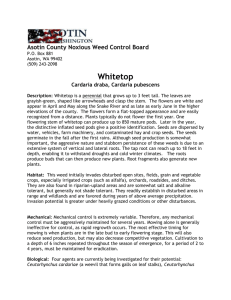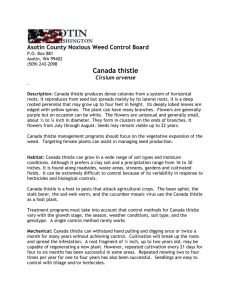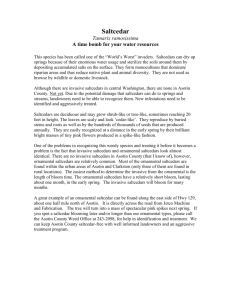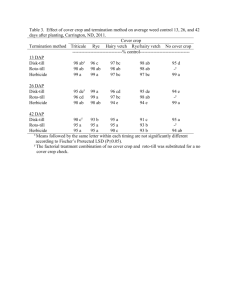Hieracium spp - Asotin County
advertisement
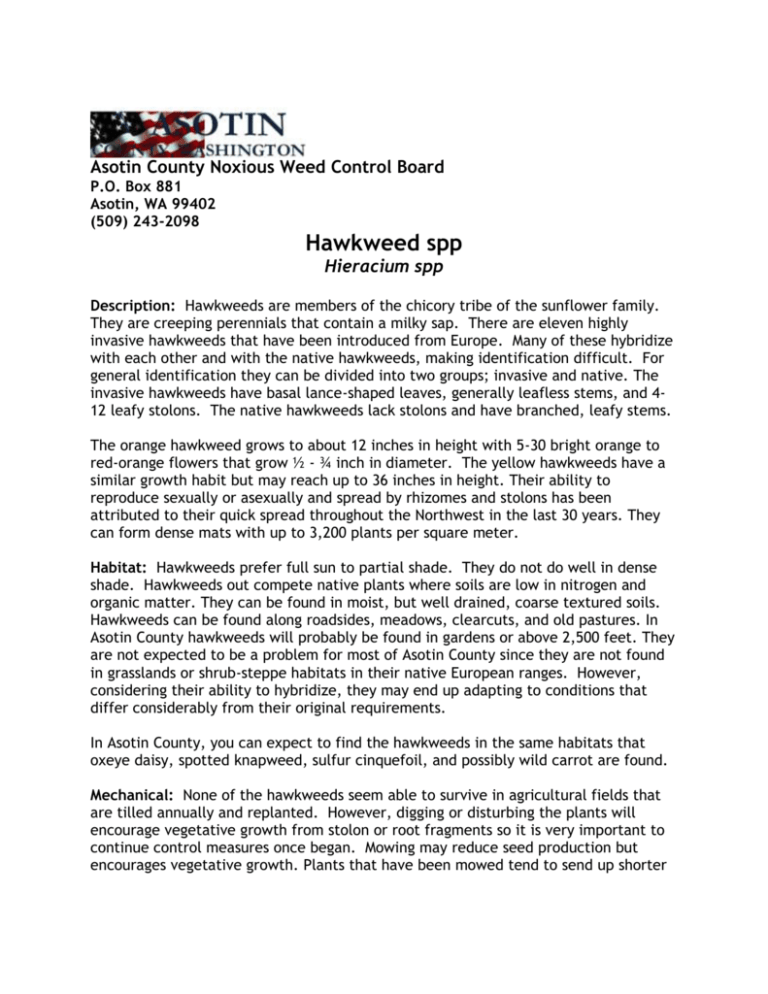
Asotin County Noxious Weed Control Board P.O. Box 881 Asotin, WA 99402 (509) 243-2098 Hawkweed spp Hieracium spp Description: Hawkweeds are members of the chicory tribe of the sunflower family. They are creeping perennials that contain a milky sap. There are eleven highly invasive hawkweeds that have been introduced from Europe. Many of these hybridize with each other and with the native hawkweeds, making identification difficult. For general identification they can be divided into two groups; invasive and native. The invasive hawkweeds have basal lance-shaped leaves, generally leafless stems, and 412 leafy stolons. The native hawkweeds lack stolons and have branched, leafy stems. The orange hawkweed grows to about 12 inches in height with 5-30 bright orange to red-orange flowers that grow ½ - ¾ inch in diameter. The yellow hawkweeds have a similar growth habit but may reach up to 36 inches in height. Their ability to reproduce sexually or asexually and spread by rhizomes and stolons has been attributed to their quick spread throughout the Northwest in the last 30 years. They can form dense mats with up to 3,200 plants per square meter. Habitat: Hawkweeds prefer full sun to partial shade. They do not do well in dense shade. Hawkweeds out compete native plants where soils are low in nitrogen and organic matter. They can be found in moist, but well drained, coarse textured soils. Hawkweeds can be found along roadsides, meadows, clearcuts, and old pastures. In Asotin County hawkweeds will probably be found in gardens or above 2,500 feet. They are not expected to be a problem for most of Asotin County since they are not found in grasslands or shrub-steppe habitats in their native European ranges. However, considering their ability to hybridize, they may end up adapting to conditions that differ considerably from their original requirements. In Asotin County, you can expect to find the hawkweeds in the same habitats that oxeye daisy, spotted knapweed, sulfur cinquefoil, and possibly wild carrot are found. Mechanical: None of the hawkweeds seem able to survive in agricultural fields that are tilled annually and replanted. However, digging or disturbing the plants will encourage vegetative growth from stolon or root fragments so it is very important to continue control measures once began. Mowing may reduce seed production but encourages vegetative growth. Plants that have been mowed tend to send up shorter stems and quickly flower. It is important to bag all cut flowers since they can form viable seeds after they are cut or dug up. Biological: At the present time there are no biological controls available for release for the hawkweeds. However, a wasp that halts stoloniferous growth is expected to be released in the near future for the control of orange and mouse ear hawkweeds. …there are 3 other biological controls that are being investigated; a gall midge that stops flowering and stolon production (not in the U.S. yet); a root feeding hover fly that weakens the plant (not in the U.S. yet); and a rust fungus that has only shown very low impact on the plants. Fire: Unknown Cultural control: Grazing by livestock and rodents encourage the spread of the hawkweeds through stimulated vegetative growth. However, it is unknown how palatable the hawkweeds are and to what extent they are utilized. Studies have shown that leaf protein ranges from 7-11% and flowers contain up to 18% protein. Fertilizer: Nitrogen fertilizer has helped increase the competitive ability of grasses and forbs and actually suppressing hawkweed growth. This is most noticeable when sufficient stands of grass are present and the soils are nitrogen deficient. Chemical: These chemical recommendations are for noncropland areas and are summarized from the “Pacific Northwest Weed Management Handbook – 2004”. These recommendations are not intended to be a complete resource guide. Label requirements need to be followed for restrictions, concentrations, timing, and nontarget interactions. Chemical control can be effective, but must be maintained for several years to exhaust the seed bank. 2,4-D: Rate; 1.43 to 1.9 lb ae/A Time; Apply to growing plants before buds form Remarks; Retreatment will be necessary Caution; This herbicide will kill broadleaf plants. Do not contaminate water sources. Dicamba: (Banvel or Clarity) Rate; 2 lb ae/A (2 qts/A) Time; Apply to growing plants before flowering Remarks; Retreat as needed not to exceed 2 lb ae/A/season. Caution; This herbicide will kill broadleaf plants. Do not contaminate water sources. Check label for livestock restrictions. Picloram: (Tordon 22K) Rate; .25 lb ae/A (1 pint/A) Time; Apply after most basal leaves emerge but before buds form. Fall treatment effectiveness unknown Remarks; Follow label restrictions for specific sites. Caution; This is a restricted use herbicide with many years of soil residual. Follow label guidelines carefully to prevent contamination of water and injury to non target plants. Clopyralid: (Transline or Stinger) Rate; .25 to .375 lb ae/A (.66 to 1 pint/A) Time; Apply after most basal leaves emerge but before buds form. Fall treatment effectiveness unknown. Remarks; Follow label restrictions for specific sites. Caution; This herbicide has a soil residual. Follow label guidelines carefully to prevent contamination of water and injury to non target plants. Clopyralid + 2,4-D: (Curtail) Rate; 2 qts/A Time; Apply after most basal leaves emerge but before buds form. Fall treatment effectiveness unknown. Remarks; Follow label restrictions for specific sites. Caution; This herbicide has a soil residual. Follow label guidelines to prevent water contamination and injury to non target plants. Triclopyr + clopyralid: (Redeem, Confront) Rate; 1.5 to 2 pints/A Timing; Apply when weeds are actively growing. Remarks; See label for rate of nonionic surfactant and other restrictions. Caution; This herbicide contains a soil residual. Follow label guidelines carefully to prevent contamination of water and injury to non target plants. Do not apply more than 4 pints/A per year. Distribution: There is a patch (10’ x 20’) of orange hawkweed close to Field Springs State Park (identified summer 03). A garden in Clarkston has a patch of one of the yellow hawkweeds (identified summer 03). Both of these patches are being controlled. ACNWCB Policy: The Board’s policy is eradication of all infestations.

